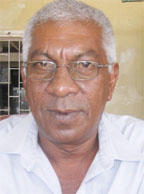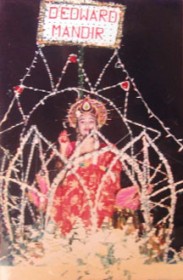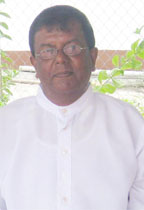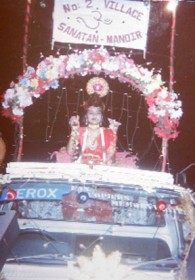Elderly Hindus in Berbice recalled that Diwali – the Festival of Lights around the 1970s was celebrated in a more humble manner with persons going to the “seaside to dig mud to make the earthen lamps [diyas].”

Rudolph Rampersaud of D’Edward, West Berbice, an active member of the D’ Edward Mandir told this newspaper that everyone looked forward to the festival back then especially when it came to making the diyas.
He recalled that after the mud is dug it would be kneaded and the diyas would be shaped into tiny bowls and then put to dry in the sun for a few hours.
Persons would make “hundreds of diyas” and would even compete with each other to illuminate their homes and yards on Diwali night which is said to be the darkest night of the year.
Sadly, he said the diyas are being replaced by fairy lights and persons would concentrate on getting the best lights instead of the most diyas. “Now the real emphasis of the Diwali is lost with the fairy lights,” he observed.
He said too that “there is no fun anymore of going to the seaside to dig the mud because persons would prefer to buy the ones that are baked or they would hang the [fairy] lights and that’s it.”
He recognized that while some homes would have just a few scattered diyas [for various reasons] others would decorate abundantly with them.
Rampersaud recalled that “the joy of the festival was more greatly expressed in the 70s and neighbours used to be closer; they used to
visit each other and share the little sweetmeats like mohanbhog, fudge, pera – that were prepared.”

Diwali is a time of “giving and sharing” and that while persons would still be engaged in those activities it is “not with the same kind of feeling.”
He said Laxhmi, the “goddess of light, knowledge, prosperity, happiness and wealth plays an important role in Diwali and she would be worshipped around this time because people want these blessings in their lives.”
According to him, the “Hindus would clean their homes and surroundings and they would perform pujas to make sure that their homes are blessed and family happiness comes their way.”
The Diwali festival marks the victory of good over evil and the lights signify the victory of brightness over darkness when Lord Rama returned to the village of Ayodhya. He had gone into a 14-year exile with his wife Sita and brother Laxman. Whilst in exile he vanquished the demon ing Ravana who had kidnapped his wife.
Upon their return to the village the people welcomed them by lighting up their streets and surroundings “because their lives were filled with darkness and they were joyful that they got light in their lives again,” according to Rampersaud.

He mentioned that in the past the “religious aspects of Diwali had more emphasis,” noting that “alcohol is not allowed at this time but these are different days and people do a lot of nonsense.”
Motorcade
Ever since the motorcade was introduced to Guyana, Hindus have had more reasons to celebrate and bring their culture alive. Rampersaud said Pandit Reepu Daman Persaud and the Guyana Hindu Dharmic Sabha should be given credit for introducing the activity.
The motorcade is held regionally and almost all mandirs would participate with vehicles decorated with fancy lights and religious symbols. A young girl, depicting the goddess Laxhmi would also be sitting on top of the vehicle in a lotus flower.
All the vehicles would gather at one particular village and the convoy would then head to a different mandir each year for a cultural presentation which includes songs, dances and skits depicting the festival.
Dhanan Narayan of Cotton Tree told this newspaper that the Blairmont Centre Ground is now the permanent venue for the event. He recalled that initially just a few trucks, cars and tractors and trailers used to be involved in the motorcades.
“We did not have so much fairy lights then but all the vehicles used to dress up with fancy battery lights that were painted and decorated with crepe paper.” The floats were also bedecked with flowers and palm plants which added a natural beauty.

Narayan said he used to provide three of his trucks for Blairmont, Cotton Tree and Rosignol mandirs to use for the motorcade.
“In those days I used to drive truck from Blairmont to Linden and on the day of the motorcade I would leave home at 2 am just to get home early so they can do the decorating. After the shows ended at 11 pm I would go home, remove the decoration and still work the next day.”
Now, he said because of the amount of fairy lights that are used to decorate the vehicles, persons would have to start from weeks ahead. He recalled that residents used to line the roadways in anticipation of the motorcade. At that time, free transportation even used to be provided for those desirous of going to the show.
He said the free cultural show is “much bigger now because more people would go with their own vehicles. We used to have about 3,000 persons but now we are getting about 7,000.”
The motorcade, held at the Blairmont Community Cen-tre Ground last Saturday night has been the venue for the past few years and Narayan was grateful to Guysuco for assisting with the stage, lighting facilities and security.
Dr. Narine Datt Sooknanan of New Amsterdam said while growing up at Crab-wood Creek which was a poor agricultural area, the celebration of Diwali was very simple.
“I remember we used to go to church, then go house to house to sing and eat sweetmeats and I would just enjoy the fun,” he said. “We were more united in the whole village and everybody would take part.”
Young people would choose to enjoy Diwali now by lighting firecrackers and “spinning the steel-wool” but Dr. Sooknanan who belongs to the Araya Samaj group said that “in my days we never had that.”
He said the area did not have electricity at the time and no one knew about fairy lights but homes were beautifully illuminated with lots of locally made diyas.
“All the homes used to have a lot more diyas than now. Some families would even make kajol [soot] by covering a diya with another one.”
This would be used under the eyes as eyeliner.
Dr. Sooknanan told this newspaper that a trip to India during the Diwali festival proved that the festival is celebrated differently.
He said some would “sport and consume alcohol to celebrate the end of the harvest season and exchange gifts” while others would be engaged in religious rituals. They would also decorate with lots of diyas and display beautiful fireworks. “There would be so many fireworks you can hardly breathe,” he said.
Meanwhile in a message to Hindus at the East Berbice motorcade at Number Two Village, East Canje, Pandit Suresh Sugrim urged that “you should not only kindle the light on Diwali night but look at the darkness within your hearts and remove it.”
The darkness, he said referred to the hatred, jealousy, anger among other ills “which can only be rekindled by looking out for the less fortunate and sharing with them. Only then we can send forth that radiance to others.”
He recalled that “as a little boy growing up on the Corentyne, Diwali was the main festival which created a bonding with persons of all religious backgrounds. “We came together as a family and would sit and partake in a meal; there was great bonding.”




